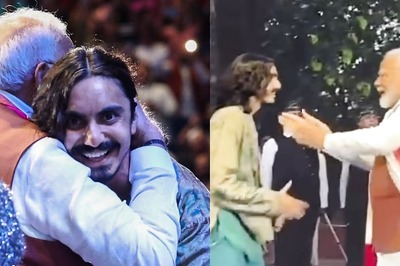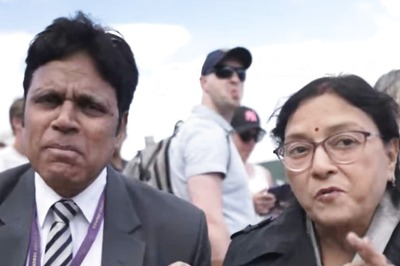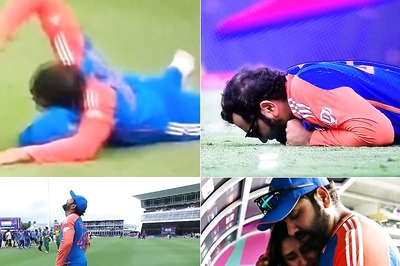
views
Few events leave a permanent imprint on the human mind, and there are few iconic moments that no one wants to end. But they do end, nevertheless. One such event was the recently concluded 17th Paralympic Games.
I write this piece less than seventy hours after the stunning closing ceremony, which also took the name “Paris est une fête” (Paris is a Party), declared the Paris 2024 Games officially closed at the magnificent Stade de France stadium. With a record 64,000 spectators singing, clapping, chanting, and dancing in the rain, the event celebrated the grit, determination, resilience, persistence, and perseverance of 4,400 athletes from around the world who gathered in Paris to participate in the seventeenth Paralympic Games.
The Revolution
As exemplified by the theme at the opening ceremony of the Paris 2024 Paralympics, the agenda of the seventeenth edition of the games extended far beyond sports. Its goal was an ‘inclusive revolution’, which began with a fully inclusive and accessible Games Village, as well as efforts to make Paris reasonably inclusive for the para-athletes. Andrew Parsons, President of the International Paralympic Committee, succinctly captured the essence: “We all have a collective responsibility to use the momentum of the Paris 2024 Paralympic Games to make the world around us more inclusive. What a Paralympic legacy this would be, not just for these athletes, but for the world’s 1.3 billion persons with disabilities that they represent.”
This author, who has worked for decades to bring about change in the lives of disabled Bharatiyas, humbly posits that the stupendous performance of Indian para-athletes at Paris 2024 should have served as a wake-up call—a call for a more “inclusive India,” which remains the most pressing need for the nation. Alas, it was not to be.
4400 Amazing Tales
Indubitably, Paris 2024 was a never-before-seen, breath-stopping sporting pageant. But it was much more than that. It was about a new “inclusion revolution” woven around the drapery of 4,400 incredible, inspirational tales of men and women from 168 countries, a group of refugee athletes, and hundreds of neutral athletes showcasing their craft across 549 events spread over 22 sports, sharing the excitement of Para sport with the spectators for the first time in eight years.
The story of each of the 4,400 athletes who set Paris alight for 12 days is amazing and beyond the scope of this piece. However, I will discuss two of the most inspiring tales in a while.
The Parity
The Paris 2024 Paralympics will go down in the annals of history for setting a new benchmark in gender parity. There were 1,983 women in the fray, constituting 45 per cent of the total 4,400 athletes, surpassing the Tokyo 2020 record of 1,846 women (42 per cent of a total 4,393 athletes). Women athletes at Paris 2024 were more than double the number at Sydney 2000, where 988 female athletes participated.
The story of gender parity within the Indian contingent at Paris was equally impressive. Women made up a record 32 out of the total 84 athletes, more than double the number from Tokyo 2020, where the Indian contingent had 14 women out of 54 athletes.
Those Twelve Days
The climax of the last day of the games was marked by a stupendous performance from the star of the final day, Morocco’s female runner Fatima Ezzahra El Idrissi. She broke the women’s marathon world record by finishing in 2 hours, 48 minutes, and 36 seconds. And what a race it was.
For the sixth consecutive time—a sporting feat that began in Athens in 2004—China finished at the top of the gold medal table with a score of 94-76-50=250. China’s supremacy is evident from the fact that, in both gold medals and total medals, it won nearly double the number of medals compared to the second-ranked Britain, which had a tally of 49-44-31=124. The former powerhouse USA finished a distant third with 105 medals, including 36 gold, 42 silver, and 27 bronze.
The Telescopic Vision
Another way to assess the performance of various countries is to consider the cumulative medal tally from the first Paralympics in 1960 to the latest in 2024. Despite China’s recent surge to top the medal tally, the United States of America (961-908-852) and the United Kingdom (721-683-684) continue to hold the top two ranks with a total of 2,721 and 2,088 medals, respectively. China, with an aggregate of 1,519 medals (648-496-375), is rapidly closing the gap with Britain.
Canada (1,300), France (1,347), Australia (1,303), West Germany (938), Netherlands (886), East Germany (1,041), and Poland (821) complete the top ten countries with the highest aggregate medal counts over the Paralympics’ history.
The Elephant Awakening
India’s performance in the Seventeenth Paralympics (its Thirteenth appearance) represents a significant moment of awakening. I will capture the full story of India’s achievements in a separate section. For now, it suffices to say that with a record 7 gold, 9 silver, and 13 bronze medals, totalling 29 medals, India catapulted to 18th position in the overall medal tally. Had it not been for the fewer gold medals, India would have been comfortably positioned at 13th, in the company of Canada (29 medals) and above Uzbekistan (26 medals), Iran (25 medals), Poland (21 medals), and Switzerland (20 medals).
To provide a broader perspective, India’s total medal tally has been far superior to erstwhile powerhouses such as Sweden, South Korea and Poland, among others. However, in terms of aggregate medals won across all editions of the Paralympics, India, with 60 medals (16 gold, 21 silver, and 23 bronze), is ranked a lowly 56th among 134 medal-winning countries. Nevertheless, based solely on its performance in the last two Paralympics (Paris and Tokyo), India has jumped 25 positions to achieve this 56th rank. If the country maintains its momentum, a much brighter future awaits India at this highest level of competition.
A Tale of Two Titans
First, The Pioneer: Belonging to Fairfield, Iowa, USA, Matt Stutzman astounded the world by winning a gold medal in Paris, defeating China’s Ai Xinliang in the men’s individual compound open event. In the process, he set a new Paralympic record with 149 points scored out of a maximum possible 150.
What makes Stutzman’s achievement even more remarkable is that he was born without arms and uses his legs to shoot arrows, unlike other para-archery competitors who, despite some form of impairment, can use their arms to hold the bow. Stutzman first came to international prominence twelve years ago at the London Paralympic Games, where he won a silver medal.
Stutzman is no stranger to medals and records, having excelled in past World Archery Para Championships. He won a team gold in 2015, an individual bronze in 2019, an individual gold in 2022, and a team bronze in 2023. Remarkably, in December 2015, Stutzman set a world record for the furthest accurate distance shot—previously held by a person without a disability.
Second, Sensational: Born armless in a small village in Jammu and Kashmir due to a rare medical condition called ‘phocomelia,’ Sheetal Devi’s life seemed destined to be filled with challenges. However, she defied the odds with her extraordinary passion, zeal, perseverance, and hard work.
Sheetal Devi is no ordinary athlete. At the age of 16, she was awarded the prestigious Arjuna Award by the President of India for her stellar performance at the Hangzhou Asian Games 2023, where she won a hat-trick of medals: two gold medals in the singles compound and mixed doubles compound, and one silver in the women’s doubles. Astonishingly, she also claimed a silver medal in the open women’s compound archery event at the World Archery Para Championships 2023 in the Czech Republic, becoming the first female armless archer to win a medal at the Para World Championships, and only the second in the world after Matt Stutzman.
At the age of 17, Sheetal made history by becoming the youngest medal winner for India in the Paralympics. She won a bronze medal in the mixed team compound archery event in Paris, partnering with Rakesh Kumar. As the only teenager and the only female “armless archer” in the world, she exemplifies how physical limitations are no barrier to achieving greatness.
Before winning the mixed team compound archery bronze medal, Sheetal stunned the world with her performance in the individual compound archery event at Paris 2024. She “opened with a bull’s-eye,” receiving thunderous applause from spectators and experts alike, and set social media ablaze, with praise from figures such as French soccer player Jules Koundé and British broadcaster Piers Morgan. Despite breaking the Paralympic record with 703 points out of 720 in the ranking round, she was surpassed by Turkey’s Öznur Cüre, who scored 704 points.
Although Sheetal was eliminated from the individual event after a narrow loss to Chile’s Mariana Zúñiga, experts described her performance as “poetry in motion.” The highest tribute came from none other than Matt Stutzman, the pioneering armless archer, who remarked that Sheetal is “the future of the sport and is going to probably inspire the next generation more than I inspired this generation.”
The story of the tango of Matt Stutzman and Sheetal Devi was so inspiring that Time Magazine, on September 3, did a special story on the two, titled “What to Know About the Armless Archers Taking the Paralympics by Storm”.
The wonder kid, Sheetal, is not the only story of folktales coming alive from Bharat’s bravehearts at Paris 2024. Over the last fifteen days, much has been written about their incredible achievements, but much remains untold. In this piece, I turn next to the anecdotes of Team India’s performance in Paris.
Journey of A Para-Athlete
Even in twenty-first-century India, with the stepmotherly treatment accorded to sports, it is immensely challenging to be an athlete. For a disabled person who dreams of being an athlete, their unrealisable dreams often die young on the altar of a thorny, winding, untravelled road.
Despite recent government support to identify, nurture, support and train athletes, corporations have yet to open their purses for para-athletes. The out-of-pocket expenses required to produce a medal-winning para-athlete at an international level are back-breaking for families. The harsh reality is that many of the 84 athletes who proudly represented India at the Paris 2024 Paralympics may find limited opportunities beyond their athletic pursuits. Without greater support, the path to a sustainable livelihood can feel impossibly narrow.
The Puzzle
SH1, F16, F15, SU5, J1 F41, T63, SL4
The above is not a puzzle to solve or a code to crack. They represent some of the classifications in which Indian Paralympians won medals at Paris 2024. Unlike the Olympics or Asian Games, where athletes must meet a qualification mark and then be the fastest or best in their discipline to win a medal, the Paralympics operates differently.
With recent government support, the lack of resources is no longer the biggest roadblock for para-athletes. Their greater challenge lies in navigating the complex World Para Athletics Rules and Regulations (latest version 2023) and understanding the classification system. This system classifies athletes into Sports Classes based on how their impairment affects fundamental activities in each specific sport or discipline, a process known as ‘athlete classification.’
For example, in the Olympics, there is just one fastest man and one fastest woman in the 100m race. In contrast, the Paralympics features 16 classes for men and 13 for women in the same distance, depending on their disabilities. According to the International Paralympic Committee (IPC), these classifications are necessary to “minimise the impact of the impairment on the athlete’s performance so that sporting excellence determines which athlete or team is ultimately victorious. Upholding the integrity of the competition is paramount for the credibility of the Paralympics.”
When it comes to classification, the system is complicated. To be classified as a para-athlete, a participant must fit into one of ten eligible impairment types, which are divided into three categories: physical impairments causing biomechanical activity limitations (such as impaired muscle power, impaired range of movement, limb deficiency, leg length difference, hypertonia, ataxia, athetosis, and short stature), vision impairment, and intellectual impairment.
Moreover, some sports, like athletics, have over 50 classes because they include competitors from all ten impairment categories. Others, such as powerlifting, have just one: limitation of the lower limbs or hips that prevents standing while weightlifting. There is no single classification system that applies to all sports.
Ghost of the Past
For Indian Paralympians in Paris, exorcising the ghost of the past was a major hurdle.
The term ‘Paralympics’ was officially approved by the International Olympic Committee (IOC) only in 1988 in Seoul, when the event was held in the same city as the Olympics for the first time. Its predecessor, the Stoke Mandeville Games, held in 1948 and 1952, was open only to war veterans. The competition was expanded to include athletes from various backgrounds in 1960 under the aegis of the International Stoke Mandeville Games Federation, which hosted the first Paralympic Games in Rome. That inaugural event featured 400 para-athletes from 23 countries competing in 57 medal events across eight sports.
India’s debut in the Paralympics was humble and sporadic, beginning in 1968 in Tel Aviv, Israel, with a team of 10 athletes (eight men and two women), who returned home without a medal. The breakthrough came in 1972 at the Heidelberg Games in Germany, where para-swimmer Murlikant Petkar won India’s first Paralympic medal—a gold medal in the 50m freestyle swimming event, setting a world record with a time of 37.331 seconds.
Despite this success, India did not participate in the 1976 and 1980 Games. The next significant achievement came in the 1984 Paralympics, held in Stoke Mandeville, Great Britain, and New York City, USA, where the five-member Indian team won four medals (two silver and two bronze), finishing joint 37th in the medal table with South Korea.
In the 1988 Paralympics in Seoul, India again returned without a medal, while South Korea, which had been ranked 37th along with India in 1984, leapt 30 positions to become the seventh-ranked nation with 94 medals (40 gold, 35 silver, 19 bronze). The trend continued in 1992 (Barcelona), 1996 (Atlanta), and 2000 (Sydney), with no medals for Indian para-athletes.
To summarise, between 1960 and 2020 (before Tokyo), Indian para-athletes had won only 12 medals (4 gold, 4 silver, 4 bronze) over sixty years. It was a significant challenge for Indian athletes at Paris 2024, but the 84-member team not only overcame this historical hurdle but also surpassed South Korea’s 83-member team in the overall medal tally, with India ranking 18th and South Korea 22nd.
The Burden of Expectations
The Indian para-athletes also carried an immense burden of expectations due to the following reasons:
One, the ignition: The first burden of expectations stemmed from the ‘ignition’ effect of the Tokyo 2020 Paralympics, held in 2021. At Tokyo, the 54-member Indian team secured an unprecedented 19 medals (5 gold, 8 silver, 6 bronze), elevating the country’s rank to 24th from 43rd place in Rio 2016, where India had won 4 medals (2 gold, 1 silver, 1 bronze). The number of medals won in Tokyo was one and a half times more than the total medals secured by India in the previous 12 editions of the games in which it participated.
Two, the momentum: To prove that the success in Tokyo 2021 was not an isolated event, the Indian para-contingent at the Hangzhou Asian Games 2023, comprising 303 athletes (191 men and 112 women), carried forward the momentum by winning 111 medals (29 gold, 31 silver, 51 bronze). This was the first time they returned with more than 100 medals in an international event.
Three, the promotion: The inaugural Para-Athletes Khelo India, organised at three venues in Delhi and featuring seven sports disciplines, became a trendsetter for identifying and nurturing para-athletes. The event, aimed at promoting para-sports and identifying young talent, saw a record participation of 1,500 athletes, 200 technical officials, 150 volunteers, 350 support staff, 300 escorts, and 20 classifiers from 36 states and Union Territories.
Four, the silent revolution: These factors led to a silent revolution, with Indian para-athletes breaking the glass ceiling at the 2023 and 2024 World Para Athletics Championships. In 2023, India returned with a record haul of 9 medals (3 gold, 4 silver, 2 bronze), ranking 14th overall. This performance was further improved in 2024, with an astounding 17 medals (6 gold, 5 silver, 6 bronze) and an overall 6th rank in the medal tally.
Five, the virtuous circle: These spectacular successes prompted the government to increase its support, providing substantial financial and other resources to para-athletes. It is estimated that the government spent Rs 74 crore on the Paris-bound contingent, more than double the amount spent for Tokyo. Additionally, when the Prime Minister of India personally acknowledges every medal winner, it strengthens the feedback loop, creating a virtuous cycle of support and achievement.
Winning is a Habit
Vince Lombardi, the author of ‘Winning is a Habit,’ famously said, “It’s not whether you get knocked down; it’s whether you get back up.” This sentiment was exemplified at the Paris 2024 Paralympics, where the entire nation rallied to instil the spirit of victory in the 84 brave Indian athletes, embodying Billie Jean King’s famous adage. King, a tennis champion who overcame immense odds to become one of the greatest players, once said, “Champions keep playing until they get it right.”
To illustrate with one example from Paris: visually impaired Simran Sharma, who placed a lowly 11th in the 100m (T13) at Tokyo, faced the disappointment of defeat in Paris when she missed the bronze medal in the 100m (T12) by just 0.05 seconds. However, she made a stunning comeback, claiming a bronze medal in the 200m (T12) with a personal best time of 24.75 seconds.
Within the larger story of the Paris Paralympic Games, there are many such stories of resilience and comebacks by Indian Paralympians, who have scripted history.
Building on the above, I assert that every member of the Indian contingent is a true winner. It’s time to look beyond the narrow focus of applauding only the medallists and instead honour all who made it to Paris 2024—those who reached the semi-finals, those who made it to the finals but missed out on medals, and those who stood on the podium. Let us celebrate the pursuit of perfection by these remarkable athletes.
The Medal Story
Since India’s debut in 1968, the country has won 60 Paralympic medals, nearly half of which—29—came in Paris. Adding the 19 medals from the 2021 Tokyo edition, Indian Paralympians have brought home an incredible 48 medals in the last three years, four times the total accumulated over sixty years. Undoubtedly, this is a time for celebration. Here is a brief overview:
- Five times Olympic medals: The impressive 29 medals not only represent India’s best performance in the Paralympics but also surpass the total number of medals won by able-bodied Indians in the Paris Olympics.
- Rise of female power: Thirty-two female participants in the Paris 2024 Paralympic Games broke the glass ceiling with a record 10 medals—one gold, one silver, and eight bronze.
- Magnificent Monday: September 2 became a historic day for India when the contingent won 8 medals in just 12 hours, marking their best-ever one-day tally in the Paralympic Games. Notably, the 8 medals won that day (2 gold, 3 silver, and 3 bronze) surpassed India’s entire medal tally from 1988 to 2016 and exceeded the total medals won in any single edition before Tokyo.
- Super Thirty: India also had its “super thirty” moment on September 3, with four medals being won in just 30 minutes, taking the Indian medal tally to 20 and breaking the Tokyo record of 19 medals.
- Bonanza: The real bonanza came in the track and field events (athletics), where 17 medals in Paris more than doubled the eight won in Tokyo. It was also tantalisingly close to Tokyo’s total medal count of 19.
- Raining gold: Paris became special for India for two reasons—a record 1.5x increase in the total medal count from Tokyo, alongside a 1.5x increase in gold medals.
- Change of colour, comebacks, and repeat medals: These were the everyday stories of the Indian team in Paris. Harvinder Singh converting his Tokyo bronze to Paris gold is just one such example.
The real winner is the relentless pursuit of “a team born unequal.” Because Team India delivered in Paris, I have in general refrained from listing the names of the medal winners in this story.
Next Stop: Mission Top Five and Mission Inclusive Revolution
It’s time to jumpstart two missions to be accomplished in four years: Mission Top Five Rank at Los Angeles and Mission Inclusive Revolution to make India disabled-friendly. For the first mission, India must broaden its participation base across the 550 events—both in terms of events participated in and the number of sportspersons per event. No country has a larger pool of disabled individuals than India, with “55 to 90 million,” according to a recent World Bank estimate. This demographic presents a potential goldmine of “Khojo-Paralympians” and a driving force for “Khelo Paralympics”. The lowest-hanging fruit? Track and field events, where the investment per sportsperson is low and the potential return high.
All Bharat needs to join the elite Top 5 club is 100 medals at the Los Angeles 2028 Paralympics. It’s eminently doable, and the time starts now. Considering that in the last three years (2021–2024), between Tokyo and Paris, Indian Paralympians have amassed 48 medals, 100 medals in 2028 is not a far-fetched dream.
The author is Multidisciplinary Thought Leader with Action Bias, India Based International Impact Consultant, and keen watcher of changing national and international scenarios. He works as President Advisory Services of Consulting Company BARSYL. Views expressed in the above piece are personal and solely those of the author. They do not necessarily reflect News18’s views.




















Comments
0 comment